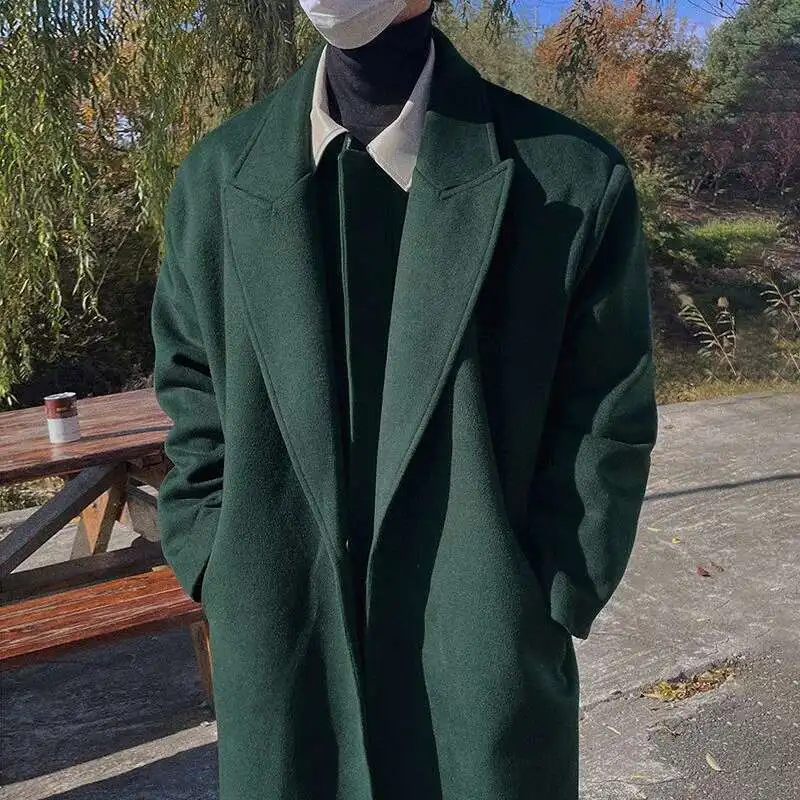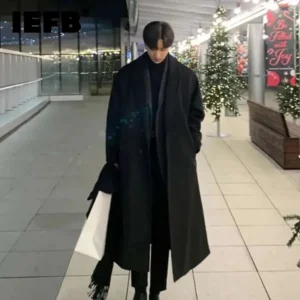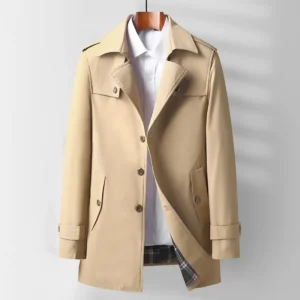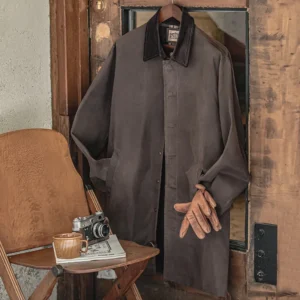Introduction to Herringbone Coats
Herringbone stands as one of the most recognizable and enduring patterns in men’s fashion. This distinctive textile weave creates a zigzag pattern resembling the skeleton of a herring fish—hence the name. The characteristic V-shaped columns alternate direction, creating a broken zigzag visual that adds depth and texture to any garment it adorns.
The herringbone pattern boasts centuries of history, dating back to the Roman Empire where it was first used in road paving systems. In men’s fashion, herringbone rose to prominence in the early 20th century when it became associated with sophistication and refined taste. Icons of style from British aristocracy to Hollywood legends have embraced herringbone coats as staples of their wardrobes.
What makes herringbone coats so enduringly popular?
- Timeless appeal that transcends seasonal trends
- Distinctive texture that adds visual interest without being overpowering
- Versatility across formal and casual settings
- Structural integrity that allows garments to maintain shape and drape beautifully
This guide will help you navigate the world of men’s herringbone coats, explaining what sets quality examples apart and how to select the perfect coat for your wardrobe. We’ve carefully evaluated options based on material quality, construction techniques, styling versatility, and overall value to bring you comprehensive recommendations.
What Makes Herringbone Weave Special
The herringbone weave isn’t just visually striking—it’s a textile achievement that combines beauty with practicality. At its core, herringbone is created through a twill weaving technique where the weft threads are reversed at regular intervals to create the distinctive broken zigzag pattern. This technique produces a fabric with remarkable structural properties.
Up close, herringbone reveals its intricate beauty. The pattern creates a surface with subtle dimensionality—capturing and reflecting light differently across its angled sections. This gives herringbone fabrics a dynamic quality that flat weaves simply cannot match. The depth and movement in herringbone patterns provide visual interest without the boldness of plaid or the formality of pinstripes.
Beyond aesthetics, herringbone offers practical benefits. The interlocked weave creates a stronger, more durable fabric than simple weaves. This structural advantage explains why herringbone has been favored for outerwear designed to withstand years of wear. When compared to other classic patterns, herringbone occupies a sweet spot between the rustic character of tweed and the refined elegance of houndstooth.
The beauty of herringbone lies in its dual nature—it’s sophisticated yet approachable, textured yet refined, distinctive yet versatile. Understanding the herringbone coat pattern helps appreciate why this weave has endured while other patterns have faded from fashion.
Types of Men’s Herringbone Coats
Herringbone appears across various coat styles, each offering different levels of formality and functionality. Understanding these distinctions helps in selecting a coat that best suits your lifestyle and wardrobe needs. The appropriate coat length is a critical factor that significantly influences both style and functionality.
The Classic Herringbone Overcoat
The herringbone overcoat represents the pinnacle of refined outerwear. These distinguished garments typically feature:
- Length extending below the knee for maximum coverage and warmth
- Structured shoulders creating a clean, formal silhouette
- Traditional materials like 100% wool or luxury wool-cashmere blends
- Single or double-breasted front closures with substantial buttons
- Wide lapels that can be turned up against cold weather
Herringbone overcoats excel in formal settings, perfectly complementing business suits and evening wear. The structured design and longer length create a commanding presence suitable for professional environments and special occasions. Many quality overcoats feature canvassed construction—an internal structure of horsehair canvas that allows the coat to mold to the wearer’s body over time.
The classic overcoat in herringbone makes an excellent investment piece within the men’s wool overcoat category, as its timeless design remains relevant year after year, making it a true wardrobe cornerstone.
The Versatile Herringbone Sport Coat
The herringbone sport coat offers a more casual and versatile alternative to the formal overcoat. Key characteristics include:
- Shorter length typically ending at the hip or upper thigh
- Less structured shoulders for a relaxed silhouette
- Often crafted from lighter weight wool or wool blends
- Notch lapels and patch pockets for a more casual feel
- Elbow patches occasionally added for durability and visual interest
The beauty of herringbone sport coats lies in their adaptability. They effortlessly bridge formal and casual settings, pairing equally well with dress trousers or premium denim. For business casual environments, a herringbone sport coat with chinos creates a sophisticated yet approachable look. For weekend outings, the same coat works beautifully over a simple sweater with dark jeans.
Seasonally, herringbone sport coats can work year-round depending on fabric weight—lighter versions for transitional seasons and heavier options for winter wear. This adaptability makes them exceptional value in any wardrobe.
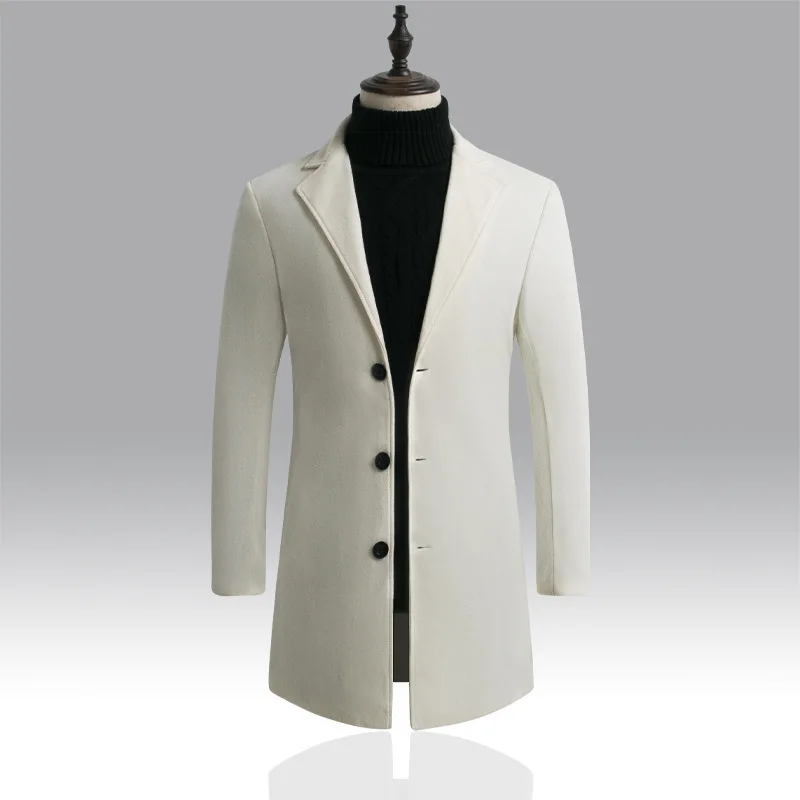
Our Top Herringbone Coat Selections
After extensive evaluation of countless options across the market, we’ve curated selections that represent the finest herringbone coats available. Our assessment focused on four key criteria: quality of materials, excellence in construction, styling versatility, and overall value proposition.
The following recommendations span different price points, recognizing that quality can exist at various investment levels. We’ve focused on coats that offer genuine longevity in both construction and design, prioritizing timeless silhouettes over trendy details that quickly become dated.
For each selection, we’ve highlighted distinctive features and specific qualities that set these garments apart. Understanding the importance of proper fit, we’ve also considered how these coats accommodate different body types and how men’s coat length affects the overall appearance.
Premium Herringbone Overcoats
At the premium level, herringbone overcoats demonstrate craftsmanship that justifies their investment:
The Luxe Herringbone Overcoat exemplifies traditional tailoring excellence with:
– 100% virgin wool from prestigious European mills
– Full canvas construction that molds to the wearer over time
– Hand-finished buttonholes and genuine horn buttons
– Cupro lining for smooth wearing and breathability
– Traditional 3/4 length providing coverage while maintaining mobility
The Metropolitan Herringbone Coat offers a more contemporary interpretation with:
– Wool-cashmere blend combining warmth with luxurious softness
– Half-canvassed construction balancing structure with lighter weight
– Clean, minimalist front with concealed closure system
– Versatile mid-thigh length suitable for both formal and business casual settings
– Subtle contrast under-collar detail for added sophistication
These premium options represent the pinnacle of the men’s long overcoat category, where traditional craftsmanship meets contemporary design sensibilities.
Mid-Range Herringbone Coats with Exceptional Value
Mid-range options provide excellent quality-to-price ratio for discerning buyers:
The Heritage Herringbone offers impressive features typically found at higher price points:
– Wool-blend fabric with natural stretch for comfort and movement
– Clean chest construction with lightweight padding for shape without bulk
– Durable Bemberg lining ensuring years of wear
– Traditional details like ticket pockets and functioning sleeve buttons
– Versatile charcoal herringbone pattern that coordinates with most wardrobes
The Urban Commuter herringbone coat balances practicality with style through:
– Water-resistant wool blend perfect for unpredictable weather
– Modern shorter length ideal for urban environments
– Technical interior details including media pockets and wind guards
– Reinforced stress points ensuring durability during daily wear
– Clean silhouette that works with both formal and casual attire
These coats compare favorably with many options in the broader men’s tweed coat category, offering similar quality with the distinctive herringbone pattern.
Modern Herringbone Sport Coats for Versatile Styling
Contemporary sport coat options showcase how herringbone continues to evolve:
The Weekday-to-Weekend sport coat excels through versatility:
– Unstructured design providing comfort without sacrificing style
– Medium-weight wool suitable for year-round wear in most climates
– Modern fit with slightly shorter length and trimmer proportions
– Natural shoulders that work equally well with or without a tie
– Adaptable medium grey herringbone that pairs with virtually everything
Style this coat with wool trousers and a light blue shirt for office settings, or dark denim and a merino sweater for sophisticated weekend wear.
The Creative Professional sport coat offers distinctive modern touches:
– Bold, oversized herringbone pattern creating visual interest
– Slightly extended length providing a contemporary silhouette
– Patch pockets and contrasting elbow patches adding casual character
– Partial lining improving breathability and reducing weight
– Subtle texture variations within the herringbone pattern
This coat shines in creative professional environments paired with solid trousers and textured knitwear, or with quality jeans and a crisp white shirt for evening social occasions.
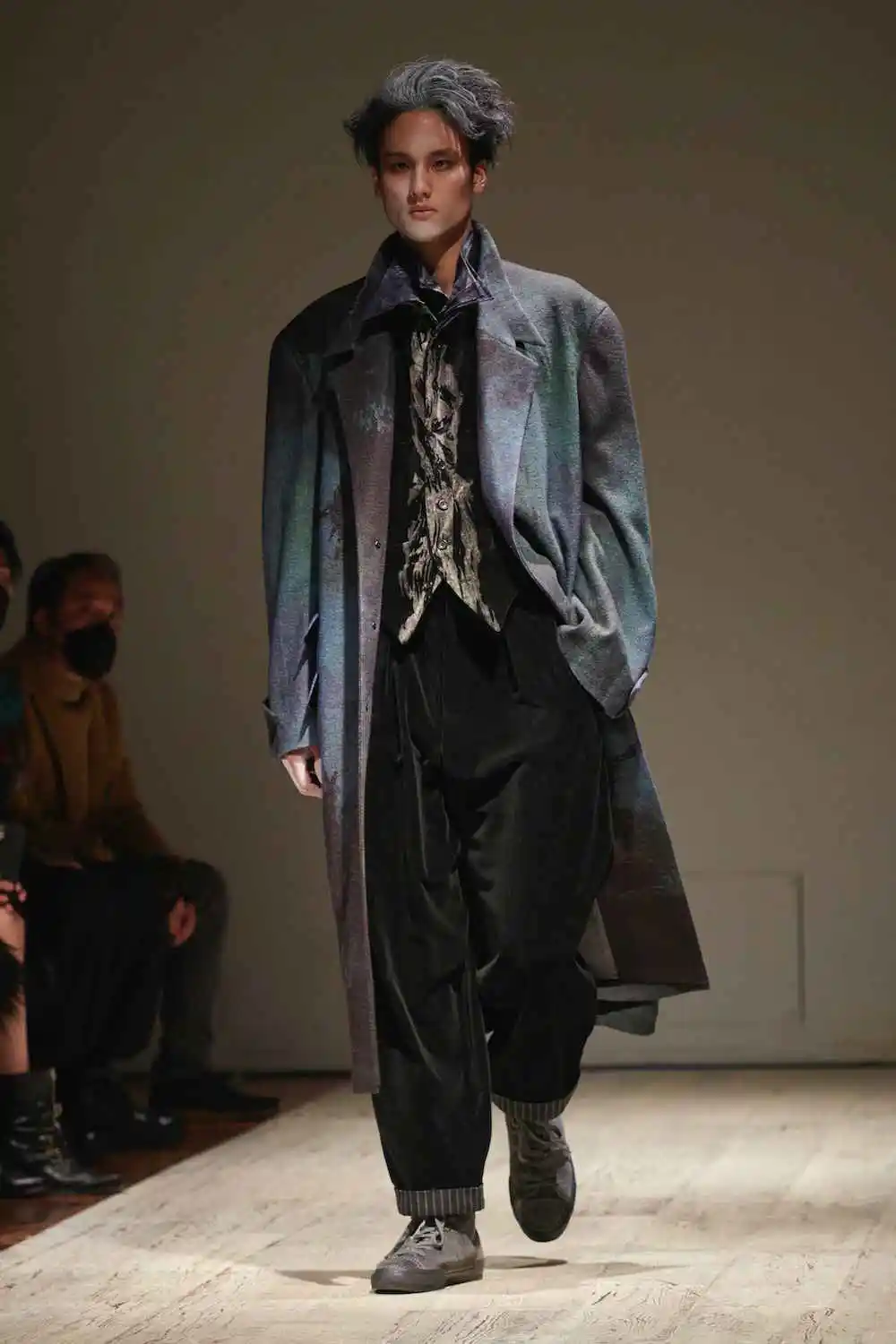
How to Choose the Right Herringbone Coat
Selecting the ideal herringbone coat requires consideration of several key factors to ensure it meets your specific needs and complements your existing wardrobe.
Occasion and Usage
Begin by assessing where and how often you’ll wear your coat:
– For primarily business settings, longer overcoats in traditional patterns offer appropriate formality
– For versatile day-to-evening wear, mid-length options provide greater flexibility
– For primarily casual use, shorter coats or sport coats in bolder patterns work well
Material Considerations
The fabric composition significantly impacts performance and comfort:
– 100% wool offers excellent temperature regulation and natural water resistance
– Wool-cashmere blends provide increased softness but may require more delicate care
– Wool blends with synthetic additions often improve durability and wrinkle resistance
Fabric weight also matters—heavier weights (above 20 oz) provide superior warmth but less versatility across seasons, while medium weights (16-20 oz) offer better year-round potential.
Color Selection
While traditional herringbone appears in greys and browns, consider:
– Charcoal or mid-grey for maximum versatility with both black and brown accessories
– Navy herringbone for a distinctive yet conservative choice
– Brown tones for a softer appearance that pairs beautifully with earth-toned wardrobes
– Black herringbone for maximum formality, though with somewhat reduced versatility
The best colors for herringbone coats often depend on your existing wardrobe and personal coloring.
Quality Indicators
Regardless of price point, look for these markers of quality:
– Dense, tight weaving with clear pattern definition
– Substantial buttons securely attached with sturdy thread
– Clean, even stitching with appropriate stitch density
– Smooth lining attachment without puckering or pulling
– Properly matched patterns at seams and pocket placements
The perfect coat length for your height is another crucial consideration that affects both appearance and practicality.
Finding Your Perfect Fit
A well-fitting coat makes all the difference in both comfort and appearance:
Key measurement points include:
– Shoulders: The seam should end at your shoulder edge, not before or beyond
– Chest: Allow 2-4 inches of room beyond your chest measurement
– Sleeve length: Should reach the base of your thumb when arms are relaxed
– Overall length: Depends on coat style but should be proportional to your height
Different body types benefit from different proportions:
– Athletic builds generally suit slightly fitted waists with room in shoulders
– Broader builds benefit from straight cuts with minimal tapering
– Taller individuals should seek longer lengths to maintain proportion
– Shorter individuals typically benefit from shorter coats to avoid overwhelming the frame
Remember that outerwear needs to accommodate layering—when trying on, wear similar layers to what you expect to wear underneath during actual use.
Styling Your Herringbone Coat: Versatile Outfit Ideas
The beauty of herringbone lies in its versatility across different dress codes and occasions. Here’s how to maximize the styling potential of your herringbone coat:
Formal Business Attire
For professional environments and formal occasions:
– Pair a long herringbone overcoat with a dark suit, white shirt and silk tie
– Complement with leather oxford shoes and minimal accessories
– Consider a cashmere scarf in a solid color that picks up secondary tones in the herringbone
– Keep gloves and other accessories in coordinating leather for a cohesive look
Business Casual Ensembles
For versatile office-appropriate looks:
– Layer a mid-length herringbone coat over a merino sweater and button-down shirt
– Pair with well-cut chinos or wool trousers
– Add leather loafers or chelsea boots
– Incorporate a pocket square for a refined touch without the formality of a tie
Smart Casual Weekend Wear
For elevated off-duty style:
– Combine a herringbone sport coat with premium dark denim
– Layer with textured knitwear like a turtleneck or shawl-collar sweater
– Choose boots or premium sneakers depending on the setting
– Add casual accessories like a knit beanie or textured scarf for personality
Understanding the differences between short versus long coats helps determine which style will best complement different outfits and occasions.
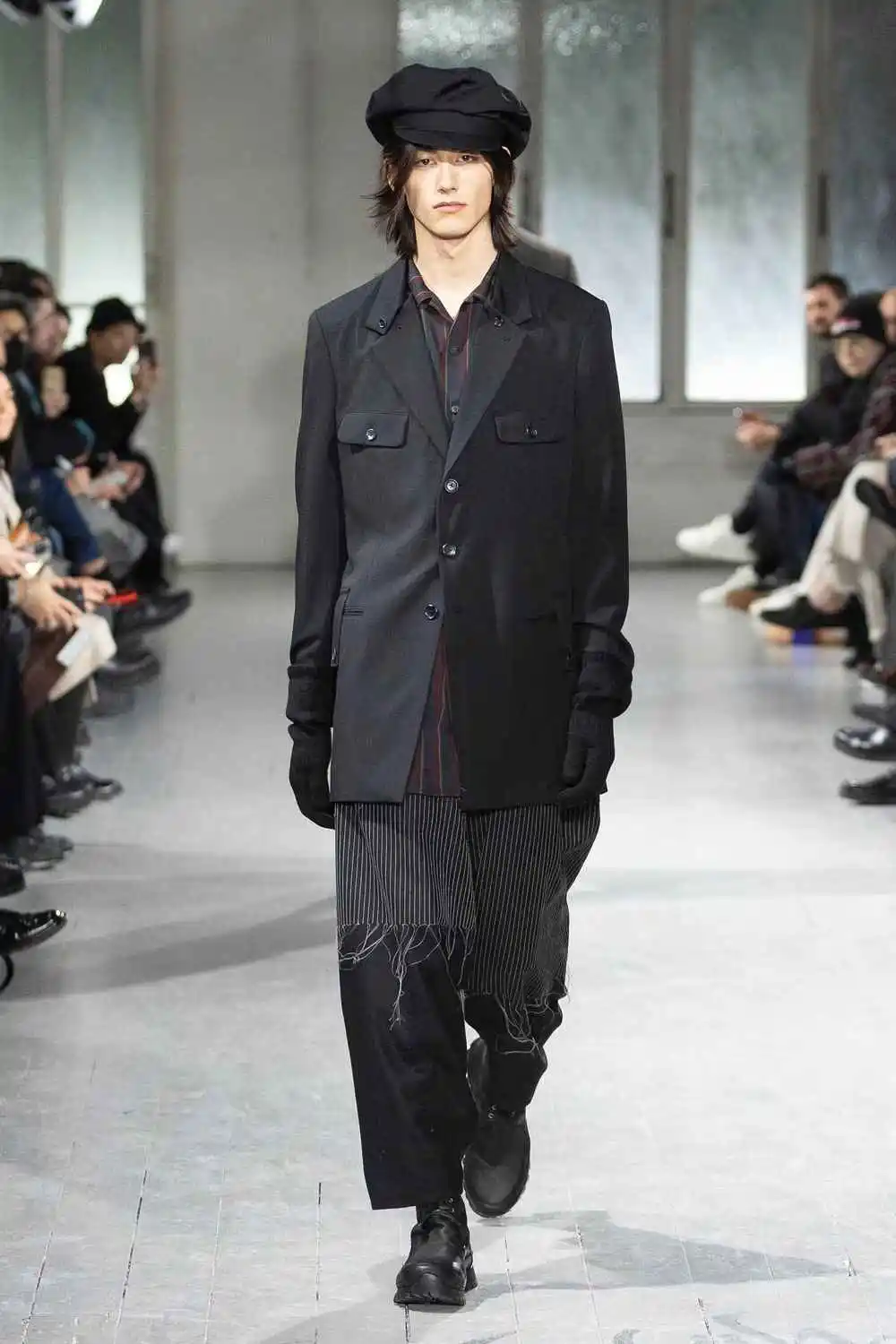
Seasonal Styling Considerations
Adapt your herringbone coat across seasons for maximum versatility:
Winter Styling
- Layer over heavier knitwear or suits for additional warmth
- Incorporate scarves, gloves, and hats in complementary fabrics
- Consider liner-equipped models for extreme cold conditions
- Pair with water-resistant footwear for practical winter dressing
Fall Transition
- Layer over lightweight sweaters or just a shirt for moderate temperatures
- Pair with seasonal fabrics like corduroy or moleskin trousers
- Incorporate earth tones that complement the herringbone pattern
- Leave unbuttoned for a more casual, layered appearance
Early Spring
- Wear open over lighter layers as temperatures begin to rise
- Switch to lighter-weight trousers and less substantial footwear
- Incorporate brighter accent colors through accessories
- Consider shorter coat styles that feel less heavy as the season changes
Mens Cashmere Overcoat, Mens Hooded Winter Coat, Mens Wool Blend Coat
Price range: $128.72 through $139.68 Select options This product has multiple variants. The options may be chosen on the product pageMens Black Overcoat, Mens Black Wool Coat, Mens Wool Overcoat
$339.18 Select options This product has multiple variants. The options may be chosen on the product pageMens Grey Overcoat, Mens Wool Blend Coat, Mens Wool Overcoat
$201.28 Select options This product has multiple variants. The options may be chosen on the product pageMens Herringbone Coat, Mens Long Overcoat, Mens Wool Overcoat
Price range: $197.16 through $203.69 Select options This product has multiple variants. The options may be chosen on the product pageMens Long Overcoat, Mens Topcoats
Price range: $189.40 through $196.88 Select options This product has multiple variants. The options may be chosen on the product pageMens Long Overcoat, Mens Tweed Coat
Price range: $397.49 through $409.96 Select options This product has multiple variants. The options may be chosen on the product page
Care and Maintenance for Herringbone Coats
Quality herringbone coats represent a significant investment and deserve proper care to maintain their appearance and extend their lifespan:
Cleaning and Storage
- Brush after each wearing with a natural-bristle clothing brush to remove surface dust and debris
- Spot clean minor stains promptly using appropriate fabric cleaners
- Dry clean sparingly—only when genuinely necessary, as excessive cleaning can damage wool fibers
- Allow full drying before storing to prevent mildew or musty odors
- Store on broad, shaped wooden hangers that support shoulders without stretching
- Use breathable garment bags during off-season storage rather than plastic
Addressing Common Issues
- For minor pilling, use a fabric shaver designed specifically for wool
- Steam rather than iron to remove wrinkles and refresh the fabric
- Treat any moth damage immediately to prevent spreading
- Have loose buttons re-secured promptly to prevent loss
- Address lining tears early before they expand or affect the outer fabric
Regular maintenance keeps your coat looking its best while significantly extending its useful life, making your investment in a quality piece from the men’s overcoats collection even more worthwhile.
Shopping Considerations: What to Look For
When evaluating herringbone coats across different price points, focus on these key aspects:
Construction Quality
- Examine seams for straight, even stitching with appropriate stitch density
- Check pattern matching at seams, pockets and closures
- Assess button quality—horn or corozo buttons offer superior durability and appearance
- Evaluate lining attachment, which should be smooth without puckering
- Inspect internal structure—better coats feature canvas rather than fusible interfacing
Material Assessment
When handling the fabric, quality herringbone should:
– Feel substantial and dense, not flimsy or overly light for its intended use
– Demonstrate clear pattern definition with crisp edges to the herringbone lines
– Show consistency in weave tension throughout the garment
– Recover quickly when crushed in your hand, indicating resilient wool content
– Offer a smooth hand-feel without scratchiness (especially in premium options)
Value Indicators
True value transcends initial price:
– Consider cost-per-wear based on versatility and durability
– Evaluate styling choices—simpler designs tend to remain relevant longer
– Assess adaptability across your existing wardrobe
– Consider maintenance requirements and cleaning costs over time
– Look for timeless proportions rather than trend-driven extremes
Herringbone Patterns: Traditional vs. Contemporary
Herringbone continues to evolve while maintaining its classic appeal:
Traditional Herringbone
Classic herringbone typically features:
– Small to medium-scale pattern with high definition
– High contrast between yarns for clear pattern visibility
– Traditional colorways in greys, blacks, and browns
– Consistent pattern size throughout the garment
– Often woven from heartier, more substantial yarns
Modern Interpretations
Contemporary designers refresh herringbone through:
– Oversized patterns that create bold visual statements
– Reduced contrast for subtle, understated texture
– Unexpected color combinations beyond traditional neutrals
– Variable pattern scaling within a single garment
– Blended yarns creating heathered or mélange effects
The scale of the pattern significantly impacts the coat’s character—finer herringbone reads more formal and subtle from a distance, while larger patterns make more distinctive statements.
Why Invest in a Quality Herringbone Coat
A well-crafted herringbone coat represents more than just a seasonal purchase:
Enduring Style Value
- Herringbone has maintained relevance across decades while other patterns have cycled in and out of fashion
- The pattern’s subtle texture adds interest without limiting versatility
- Quality examples improve in character with age, developing a patina unique to the wearer
- The style transcends trends, making it wearable for many years
Practical Considerations
- Superior construction ensures longer useful life, reducing cost-per-wear
- Quality wool offers practical benefits including natural water resistance and temperature regulation
- Versatile styling potential maximizes wardrobe integration and wearing opportunities
- Timeless design eliminates the need for frequent replacement due to dated styling
Sustainability Perspective
- Investing in quality reduces overall consumption and waste
- Durable natural materials like wool biodegrade at end of life
- Well-made garments can be repaired rather than discarded
- Classic designs remain wearable across decades, reducing fashion waste
Herringbone Beyond Outerwear: Complementary Pieces
The herringbone pattern extends beyond coats into other wardrobe elements:
Complementary Herringbone Items
- Herringbone trousers offer texture while maintaining formality for business wear
- Vests or waistcoats in matching or coordinating herringbone add sophistication to tailored looks
- Herringbone caps provide pattern continuity for casual outfits
- Subtle herringbone shirting offers texture without overwhelming an ensemble
Pattern Mixing Guidance
When incorporating multiple patterns:
– Vary the scale significantly between patterns (large herringbone with small check)
– Maintain a cohesive color palette to unify different patterns
– Limit to 2-3 patterns in a single outfit
– Use solid pieces as visual breaks between patterned items
The key is intentional coordination rather than rigid matching—complementary rather than identical pieces create more sophisticated combinations.
Is a Herringbone Coat Right for You?
Determining if herringbone suits your needs requires considering several factors:
Professional Suitability
Herringbone coats work exceptionally well for:
– Traditional professional environments including finance, law, and academia
– Creative industries where classic pieces with character are appreciated
– Business casual workplaces when selecting appropriate coat styles
– Client-facing roles where polished presentation matters
Personal Style Compatibility
Herringbone integrates best with:
– Classic, timeless wardrobes centered on quality over trends
– Smart casual styles balancing refinement with approachability
– Traditional menswear with contemporary proportions
– Both minimalist and more expressive personal styles, depending on the specific herringbone selected
Body Type Considerations
Different herringbone scales and coat styles complement different physiques:
– Taller individuals can generally wear larger patterns and longer coats
– Broader builds often benefit from medium-scale patterns that don’t exaggerate width
– Slimmer frames can wear both fitted and slightly oversized silhouettes effectively
– Shorter individuals typically look best in smaller patterns and proportional coat lengths
The Enduring Appeal of Herringbone: A Fashion Perspective
Few textile patterns have demonstrated the staying power of herringbone in men’s fashion. While other patterns have risen and fallen with changing trends, herringbone has remained consistently relevant across generations.
This endurance stems from herringbone’s remarkable balance of distinctive character and versatility. The pattern offers enough visual interest to elevate simple designs, yet remains subtle enough to serve as a foundation piece rather than a statement. This dual nature has allowed herringbone to transcend the typical fashion cycle.
Throughout fashion history, herringbone has adapted to changing silhouettes while maintaining its essential character. From the structured overcoats of the 1940s to the slimmer interpretations of today, the pattern has proven remarkably adaptable across different cuts and proportions.
Contemporary designers continue to find fresh expressions for herringbone, experimenting with scale, contrast, and color while honoring the pattern’s heritage. This ongoing reinterpretation ensures herringbone remains relevant to new generations of style-conscious men seeking quality with character.
The global appeal of herringbone transcends cultural boundaries, making it a truly international symbol of refined taste and appreciation for textile craftsmanship—a pattern with both history and future.

